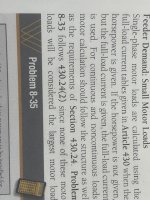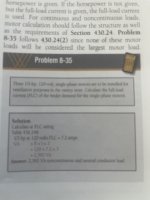Jpflex
Electrician big leagues
- Location
- Victorville
- Occupation
- Electrician commercial and residential
When trying to figure the feeder conductor demand in VA for several motors, I would think it would not make a difference if this service / feeder is for a commercial building. (Calculating feeder load demand for commercial buildings)
Apparently my code calculations book is not calculating the way I remember or learned from other books.
In this code calculations books, it says:
Three 1/3 hp, 120 volt single phase motors are to be installed for ventilation purpose in a variety store. Calculate the full-load current FLC of the FEEDER DEMAND (VA to be applied to the feeder) for the single phase motors.
The book then shows
Table 430.248
1/3 hp at 120 volts FLC = 7.2 amperes
VA = E x I x 3
2,592 VA = 120 E x 7.2i x 3
Answer 2,592 VA noncontinuous and neutral conductor load (to be applied to the feeder)
However what happened to 125% of the largest motor plus the sum of the remaining motor FLCs? Or if all motors are equal, wouldn’t you take 1 motor FLC x 125% plus the sum of remaining motor FLC
7.2 x 1.25 + 7.2 + 7.2 = 23.4i
23.4i x 120E = 2,808 VA but not 2,592 VA
Why is there a discrepancy here?
Apparently my code calculations book is not calculating the way I remember or learned from other books.
In this code calculations books, it says:
Three 1/3 hp, 120 volt single phase motors are to be installed for ventilation purpose in a variety store. Calculate the full-load current FLC of the FEEDER DEMAND (VA to be applied to the feeder) for the single phase motors.
The book then shows
Table 430.248
1/3 hp at 120 volts FLC = 7.2 amperes
VA = E x I x 3
2,592 VA = 120 E x 7.2i x 3
Answer 2,592 VA noncontinuous and neutral conductor load (to be applied to the feeder)
However what happened to 125% of the largest motor plus the sum of the remaining motor FLCs? Or if all motors are equal, wouldn’t you take 1 motor FLC x 125% plus the sum of remaining motor FLC
7.2 x 1.25 + 7.2 + 7.2 = 23.4i
23.4i x 120E = 2,808 VA but not 2,592 VA
Why is there a discrepancy here?



